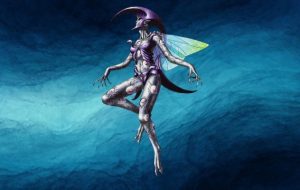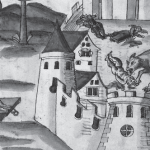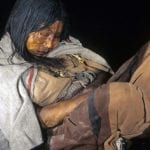 Crime
Crime  Crime
Crime  Technology
Technology 10 Hilariously Over-Engineered Solutions to Simple Problems
 Miscellaneous
Miscellaneous 10 Ironic News Stories Straight out of an Alanis Morissette Song
 Politics
Politics 10 Lesser-Known Far-Right Groups of the 21st Century
 History
History Ten Revealing Facts about Daily Domestic Life in the Old West
 Weird Stuff
Weird Stuff 10 Everyday Products Surprisingly Made by Inmates
 Movies and TV
Movies and TV 10 Actors Dragged out of Retirement for One Key Role
 Creepy
Creepy 10 Lesser-Known Shapeshifter Legends from Around the World
 Animals
Animals 10 Amazing Animal Tales from the Ancient World
 Gaming
Gaming 10 Game Characters Everyone Hated Playing
 Crime
Crime 10 Terrifying Serial Killers from Centuries Ago
 Technology
Technology 10 Hilariously Over-Engineered Solutions to Simple Problems
 Miscellaneous
Miscellaneous 10 Ironic News Stories Straight out of an Alanis Morissette Song
Who's Behind Listverse?

Jamie Frater
Head Editor
Jamie founded Listverse due to an insatiable desire to share fascinating, obscure, and bizarre facts. He has been a guest speaker on numerous national radio and television stations and is a five time published author.
More About Us Politics
Politics 10 Lesser-Known Far-Right Groups of the 21st Century
 History
History Ten Revealing Facts about Daily Domestic Life in the Old West
 Weird Stuff
Weird Stuff 10 Everyday Products Surprisingly Made by Inmates
 Movies and TV
Movies and TV 10 Actors Dragged out of Retirement for One Key Role
 Creepy
Creepy 10 Lesser-Known Shapeshifter Legends from Around the World
 Animals
Animals 10 Amazing Animal Tales from the Ancient World
 Gaming
Gaming 10 Game Characters Everyone Hated Playing
Ten Terrifying Tales of Female Demons from across the World
What do you think of when you read the word “demon?” You’d be forgiven if you thought about some little, bright red man with horns, a forked tail, and maybe some kind of sword or trident-like weapon in his hand. After all, the most natural (and superficial) connections we have to demons of old folklore come from their devilish and violent ways. So, it makes sense that their evil is seen in some devilish light—and always a masculine one, too. Right?
But the truth is that there are tons of female demons from myths, folklore, and legends passed down across history. All throughout the world, female demons have figured prominently in various religious texts, faith practices, handed-down stories, and even old wives’ tales shared across communities. So, in this list, we’ll take a look at some of those demons of the fairer sex. Today, let’s uncover ten terrifying female demons who were said to have roamed the ancient world!
Related: 10 R-Rated Facts Schools Don’t Teach About Classic Mythology
10 Hannya
Hannya isn’t just one female demon in Japanese lore, but many. Known as “oni,” or more specifically as “kijo,” when it relates specifically to female demons, hannya were said to be human women turned to demons at the end of their lives. Consumed by jealousy and rage, they were made into demonesses and left to walk the earth with their green-tinted emotions at the forefront.
There are three basic grades of hannya demons: namanari, chūnari, and honnari. The Namanari versions resemble human women but have tiny horns. They use dark magic and sorcery to perform their tricks, even going so far as to summon other more powerful demons to attack spiritual enemies and humans alike. Interestingly, these namanari demons are not fated to be evil forever; they can return to humanity in time, should they find the humanity within them before it’s too late.
Meanwhile, the chūnari are more aggressive. They are portrayed as having tusk-like fangs and much longer, sharper horns. They also exhibit more powerful and violent uses of dark magic. However, Buddhist prayers leave them vulnerable to being overcome by mortals seeking solace from their terror. As for honnari hannya, they are the most vicious of the three classes. They are true demons with serpentine bodies and breath that releases fire. They have embraced their jealousy so deeply that it consumes them, and there is no hope to calm their anger.
Followers of Japanese culture will recognize the hannya portrayals beyond simple demonology, too. Hannya is also the term used to refer to a specific type of demon mask that is very commonly used in “noh” theater. Along with that, hannya demons are referenced quite a bit in ancient and more modern Japanese literature. So the hannya demons of Japan are tightly intertwined with several aspects of that nation’s culture and history.[1]
9 Echidna
Echidna was a demon from Ancient Greek mythology, but her own personal actions weren’t as notable as the children (er… uh, monsters) she bore during her life. As a demon, she was both beautiful and terrifying to look at, with a woman’s upper body and a snake’s lower body. With her feminine but serpentine look, she attracted mates and produced offspring that would alter Greek mythology and public life for centuries to come.
Legend has it that she and her mate Typhon ended up producing several terrible heirs. Chief among them was Cerberus, commonly known as the three-headed dog tasked with guarding the underworld’s imposing gates. She also supposedly birthed the Nemean lion, the Hydra, the Chimera, and even the Sphinx! Of course, the great heroes of Greek mythology, like Heracles and others, would go on to hunt these monsters all across the world. So, in that way, Echidna had a lasting impact on Greek culture (and, by extension, the rest of the Western world) even if she didn’t directly demonize humanity.
In the end, Echidna was murdered in her sleep by the hundred-eyed giant Argus. He had gone to slay Echidna under the direction of Hera above him, and it was probably wise that he did it, for her rate of birthing monsters and nightmarish creatures was obviously second to none. In the end, her legacy still stands in that way, though. Historians continue to marvel at Echidna’s place in Greek folklore as the critical giver of (very bad and no good) mythological life that then carried stories down for centuries after that.[2]
8 Jahi

Jahi—often also known as Jeh—was a common female demon from ancient Persian texts and the Zoroastrianism faith. She was said to be the demonic embodiment of lasciviousness, and her life was devoted to serving as the close consort of Ahriman—the much-feared Zoroastrian god of evil. And in the most stark and graphic ways, many knew Jahi by the epithet of “the whore.”
True to that shocking name, Jahi was said to be an unflattering demon who could tempt men with lust and then lead them to her death. A single look could kill a man should he ever be so lustful as to lose control and pursue Jahi’s wares.
Jahi is also closely tied in with the Zoroastrianism belief in the origin of menstruation in human women. As the story goes, Ormuzd—the god of good—was able to keep Ahriman dormant for more than 3,000 years, allowing peace to fall upon the people. Sadly, Jahi was finally able to wake Ahriman from his slumber by making him become sexually aroused.
So thankful was he for being woken up to fight against Ormuzd and all the good in the world that Ahriman rewarded Jahi with the ability to menstruate. In turn, he demanded that she share it with all the mortal women of the world. The intent, according to the myth, was to defile human women forever after. It worked, and Jahi’s power spread menstruation across the globe for eternity.[3]
7 Baba Yaga
Baba Yaga is a very common character in the folklore of Slavic cultures across Eastern Europe. And because she is so common, her traits as a demon are up for debate. Some cultures believe she’s downright evil at all times, while others hold that her role is actually one of a helper or donor to a hero in various myths and stories passed down. Some Eastern European cultures even believe she isn’t one woman but three—a powerful trio of female demons who combine to become Baba Yaga and run their reign of terror across the land.
For those who believe Baba Yaga to be evil, she is most often depicted as a semi or complete cryptid creature who can morph into an old hag. She is almost always depicted in art as flying around in a mortar and carrying a pestle with her on her journey. Whether she uses it for good or evil depends on the people passing the story down, but the mortar and pestle are pretty much always part of the show.
As for her home, she is most commonly depicted as living deep in the forests away from people, residing in a hut built out of chicken bones. Because of that, much of her lore and traits are commonly associated with various forest wildlife, with believers assuming she lords over them and controls their ways.
Most commonly, her demonic traits are said to be used against children. The worst stories involve her having genie-like powers that can send kids into a trance, at which point she is said to control their lives and actions. At best, she’s a misunderstood old woman who is said to help people who venture out into the forest and get lost, directing them quietly back on their way to safety.
Either way, historians and folklore experts believe her role in the ancient world to be clear: She was used by parents as a common boogeyman (or boogeywoman) to scare their children into behaving better at home. In that sense, as any parents reading this might well attest, she could be the most important demon on this list![4]
6 Jorogumo
In Japanese folklore, jorogumo are spider-like demons who have very concerning shapeshifting abilities. They are said to be able to regularly transform themselves into the personification of beautiful women. Those women then work to attract and entice unsuspecting men. Inevitably, the interested man drops his guard, and when he does—even momentarily—the jorogumo transforms back into its spider state and kills him.
In some stories, the jorogumo are even said to have command over a series of smaller spider demons, too. The smaller demons can’t change their shapes, and they don’t have as much power as their overseer jorogumo, but they breathe fire, and they serve as the loyal army to this terrifying spirit.
Thankfully, there is one way to have these jorogumo vanquished: via the prayerful work of Buddhist monks. As with many Japanese demon legends and myths, the seduction put out by these shapeshifters can be overcome by Buddhists who pray dutifully and powerfully. But even so, while the monks may be able to keep jorogumo at bay from men in their area, Buddhism isn’t a perfect solution.
Even after overcoming the jorogumo with help from these holy men, would-be victims are said to still lust after the spiders despite knowing what they really are. The risk is ever-present, the legend goes, and jorogumo could be around any corner waiting to seduce any man seeking intimacy from what he wrongly thinks to be a beautiful woman.[5]
5 Ammit
Ammit was a very well-known demon from Ancient Egypt who was said to have the head of a crocodile, the body of a lion, and the hindquarters of a hippo. Those three animals picked weren’t an accident, either; they were the three largest, most dangerous man-eating animals known to ancient Egyptians. So to have Ammit combined as an amalgamation of all three surely conveyed her importance and power in ancient Egyptian lore.
But interestingly, even though Ammit was a feared and vaunted demon, she wasn’t necessarily seen as an evil incarnate like so many on this list. Instead, her role as a demon was to mete out divine justice. That meant leading important and lasting funeral rituals surrounding what ancient Egyptians knew as the Judgment of the Dead. As that Judgment of the Dead went, when a person died, their soul had to come before the god Anubis before they could enter the afterlife.
There, Anubis would weigh the dead person’s heart in front of them. The heart’s weight was compared to what ancient Egyptians called the Feather of Truth. If the heart weighed equal to or less than the Feather of Truth, that person’s soul was clean enough to enter the afterlife. If the heart weighed more than the Feather of Truth, the soul was banished from the afterlife forever. Anubis would then feed it to Ammit, who was waiting hungrily nearby.
For that reason, Ammit was a demon and never worshiped as a god by ancient Egyptians, even if she didn’t roam the earth, wreaking havoc like many demons we are learning about here. Still, her legend was feared all across Egypt, and the ancients hoped to go to their deaths and the afterlife without ever having to meet her.[6]
4 Ajatar
Ajatar is a horrifying demon common to old Finnish myths and legends. She was also known by the names “Ajattara,” “Aiatar,” and “Aijotar” during her run in Finnish folklore circles. According to the tale woven about her past, Ajatar lives in the forests of the Pohjola Mountains. Today, historians recognize those mountains to be a completely fictional range and believe Ajatar was very much a legend passed down in half-truths even during her “time” on earth. Still, some say “Pohjola” was an ancient name for Scandinavia as a whole and that people in what is now known as Finland really did believe her to be real and residing nearby.
In old myths, Ajatar is described as having “hair that reached to her heels” and “breasts hung down to her knees.” She was also known to be a “seawoman” in many tales and is thought to be at least partially inspired by the similar Swedish lore around Skogsnufva. Ajatar was the granddaughter of the famed Hiisi, who served as the master of the woods and the one who spread disease. Because of the connection to Hiisi, Ajatar was also responsible for spreading diseases, and she was supposedly known to wash plague and pestilence across the land as she saw fit.
Hiisi also commanded gnomes in his reign, so Ajatar was given that duty as well. And another one, too: Ajatar was supposedly the demon who looked over Lempo, the pagan god of love and fertility. That’s quite a combo—to have one female demon responsible for both love and pestilence.
However, the Finns threaded that needle for centuries in their folklore. In art and other media, her depictions are very often serpent-like. In addition to her long hair and breasts so described in some tracts, she is often said to be a dragon or, at best, a half-humanoid serpentine figure.[7]
3 Empusa
Empusa, sometimes known as Empousa, was a witchcraft-focused demon from Greek mythology. Her role in the demonic world was to serve under Hecate, the goddess of witchcraft. Empusa was said to have shapeshifting abilities, which would confound man and beast alike. But there was one way to identify her true form: by a single leg of copper that gave away her monstrous identity no matter how she shifted her shape.
Empusa’s appearances in Greek mythology are numerous. She appears in legend and lore but also shows up in several notable comedies. For one, she is mentioned in Aristophanes’s work The Frogs. In a scene in that piece, she ambushed the god Dionysus and his slave, Xanthus. She doesn’t do outright evil in that comic work, though, and some interpretations of Aristophanes’s piece today even hold that Xanthus was using her to play a lighthearted trick on Dionysus.
Elsewhere, she is mentioned in the autobiographical work The Life of Apollonius of Tyana. Written in the 1st century AD, that piece describes Empusa as having seduced one of Tyana’s impressionable young students. When the student lets his guard down, thinking he’s made it with a worldly woman, Empusa shifts her shape and devours the poor youngster. That tale is more in line with how she is often portrayed among myths and legends: the enticing shapeshifter who lures unsuspecting people to quick, grisly deaths.[8]
2 Abyzou
Abyzou was a demon that originally appeared in Akkadian legends and stories hundreds of years before the birth of Jesus Christ. She was so feared that her demonic reputation spread from there to Ancient Greece and then across the Middle East. In other cultures, she was also known by other names: Alabasandria in Egypt, Gylou in Babylon, and even Obizuth in the powerful Judeo-Christian text “Testament of Solomon,” which was written in the 1st century AD.
But besides her origin story and naming history, her actual traits were what made her legend carry on for so long. According to that “Testament of Solomon” documentation, Abyzou supposedly suffered from infertility. Angered at this, she became greatly jealous of mortal women who could have children.
That envy was so strong—and so dark—that it molded her into a demon who was destined to walk the earth with no rest. Her only job would be one simple, heartbreaking act: to cause miscarriages worldwide. She was also said to have killed newborn children, too. When they were sleeping, supposedly near the comfort of their mothers, she would stealthily sneak into their rooms and strangle them to death.
Fortunately for the ancient world, Israel’s King Solomon took action against her to stop all the mortal suffering. In that same “Testament of Solomon” text, legend has it that Solomon himself ordered Abyzou captured by his charges. Then, he strung her up by her hair in front of the Temple in Jerusalem, where she was made to suffer the ultimate punishment for her crimes. After ages of haunting, jealousy, and killing all across Mesopotamia, the Mediterranean, and the Middle East, Abyzou was said to be finally vanquished once and for all.[9]
1 Lilith
How could we write a list about demons and not include Lilith? She is, of course, the archetypal female demon based on Judeo-Christian theology. Lilith first pops up in the Book of Isaiah and is then mentioned in multiple places in Jewish mythology. According to the legend that surrounds her supposed life, Lilith was said to have been the first woman God created. Unlike Eve, though, God didn’t create Lilith from Adam’s rib.
Instead, he made Lilith from the same ground which he used to create Adam. Because of that, after she was created, Lilith refused to submit to Adam and instead demanded to go her own way. Angry at her attempt to undo God’s will, the Heavenly Father banished her from the Garden of Eden. Then, he created Eve from Adam’s rib and successfully saw to it that his new creation would submit to Adam as intended.
Lilith wasn’t done there, though. As Adam and Eve did what Christians know very well now through their biblical studies, Lilith moved on to mate with demons. In doing so, she soon became a demon herself—and she is said to have produced quite a few demon babies. Sometimes known as the “lilim,” these demon offspring are more often called the “succubi.”
Forever after, they have wandered the world, attempting to seduce men to mate with them and thus produce more succubi to wreak havoc on mortals in an attempt to seek vengeance against God and the Christian world over how Lilith was first mistreated, cast out, and left to wander alone.[10]








